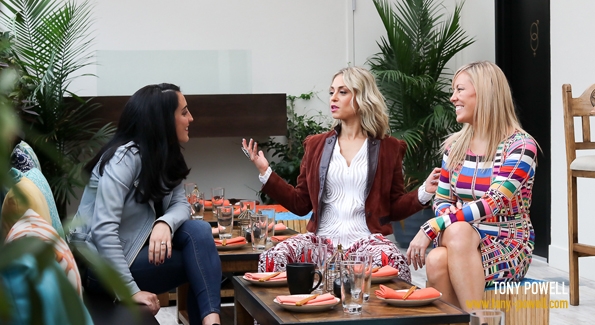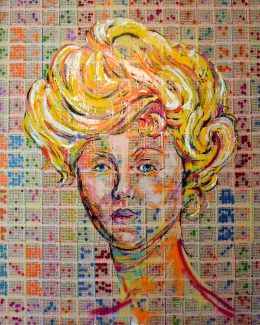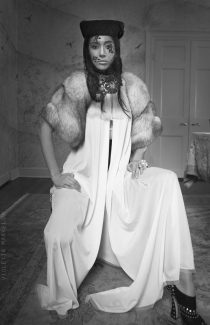Two of Washington’s female artists discuss their creative paths, gender obstacles and what the city needs to harbor success among young talent.

WL editor Catherine Trifiletti, Violetta Markelou and Maggie O’Neill. (Photo by Tony Powell)
Having grown up in the Washington area, Maggie O’Neill, an artist and co-founder of design firm Swatchroom, has been forging a path in a city known to be difficult for emerging creatives. Add being female to the equation, she says, and the way forward is wrought with obstacles. In an attempt to shine light on the local female art community, O’Neill culled a stellar lineup of women to show their art, raise money for a local breast cancer charity and participate in a mentorship program for young female artists just starting out.The traveling art exhibit Superfierce made its successful debut last year at the National Museum of Women in the Arts. The event benefitted EBeauty, an online wig exchange program for women suffering from cancer.The show is back for a month- long residency this fall from Oct. 4 to Nov. 4 at Blind Whino. As for the name Superfierce, O’Neill calls it an adjective to describe women who “have no fear and embrace the value and power in their originality.” Washington Life caught up with O’Neill and one of Superfierce’s locally featured artists Violetta Markelou,at Swatchroom-designed restaurant Sakerum to discuss problems facing the local art community, gender issues and what empowerment actually means. >>
IS WASHINGTON BEHIND IN TERMS OF FOSTERING GROWTH FOR THE CREATIVE COMMUNITY?
Violetta Markelou: We need a creative economy. I was part of the Arts District in Hyattsville for a year but once they got more rent from somebody, I didn’t have a space anymore.You can’t call yourself an arts district if people can’t live and thrive there. Artists revamp and rebuild communities all the time, but once those communities are there, then all of a sudden it’s “let’s put some bars and restaurants here that make more money.”
Maggie O’Neill: We just don’t value [creativity] as a city. We value government, we value tech, we value real estate. But all those industries need the creative community – each and every one of them – but the value isn’t reciprocated from a financial standpoint, unfortunately.
WHAT’S THE BIGGEST ISSUE WITH ARTISTS STARTING OUT?
MO: When you’re just starting out, especially in your early 20s, there’s this tremendous pressure – and thank you social media, which has just made it so much worse – that you have to go from zero to success like there’s absolutely nothing in between. The warts and the failures and the not fun stuff, no one is showing that.
VM: I agree 100 percent. Like you said, people are showing you their highlight reel. It’s really every woman for herself.
HOW DOES BEING A FEMALE ADD TO ALL THE PRESSURE?
MO: We are so good at being hard on each other, and that’s not just relating to artists. You take a secular business where you’re sort of an island, you’re out there completely vulnerable because it’s your work, and then you tack on the good old scrutiny of women.
IS PART OF SUPERFIERCE’S MENTORSHIP PROGRAM JUST SHOWING YOUNG WOMEN THAT THERE IS OPPORTUNITY OUT THERE, EVEN IF IT’S NOT NECESSARILY WHAT THEY ENVISIONED AS A WAY FORWARD?
MO: There is a business acumen part of this that could be really valuable for everybody. If you don’t go look up these things yourself, you can just get completely steamrolled. In a lot of business dealings, it’s unfortunate, but artists are the easiest people to take advantage of because it’s so nebulous and hard to nail down. With artwork, people say “this is priced at $5,000 – but I only want to pay $3,500.” Do you get to walk into a restaurant and say “I don’t want to pay $25 for that dish, I would like to pay $17?”
Once you have left the studio environment and you’re out in the world, whom do you call? I feel like my business to this point has been – it sounds cheesy, I know– a karmic loop.You have to support other artists or other creatives; there’s no less work for you and it doesn’t actually make your work less valuable.
IS “EMPOWERMENT” A BUZZWORD WHEN IT COMES TO WOMEN ADVANCING IN THEIR PROFESSIONS? WHAT DOES IT MEAN?
VM: For me it’s not a buzzword. I didn’t even realize that’s what I was doing through my work until a few years ago when someone said, “you know you really empower people.” I see it happen right in front of me during a photo shoot, after the shoot. I have to empower [subjects] to give them confidence to be in front of a camera.
MO: It’s abstract in that you don’t even know you’re doing it.You are sort of helping people feel a little bit more rooted or stronger or more confident. When you empower some- body, you actually gain more power. Some artists think there are only so many eyeballs or pocketbooks that can buy their work, so if they support this other person that somehow it takes [something] away from them. The female artist conundrum is that we have to get over that a little easier and be a lot more receptive when people reach out.
DO YOU HAVE ANY STORIES ABOUT A TIME YOU PUT YOUR EMPOWERMENT TO ACTION?
MO: I had this one crazy moment when a contractor told me that he didn’t work with “vaginas.”This was a big job for me and it was really important that I killed it.What do I do? He’s my wing man for the next six months on this project and he doesn’t want to work with me because I have a “vagina.” I was pretty devastated … paralyzed. It was so gross, I felt silly, I felt humiliated, I didn’t know if I should respond to it. My mom, who is my mentor, said to bring it up in the meeting, in front of the investors, let them know what you’re dealing with here and that you physically cannot get past the blockade in front of you because of your body part.That was such a big turning point for me … I put it in the agenda, it was agenda item 3:“my vagina.”

Goldy by Maggie O’Neill

Nadine by Violetta Markelou
This article appeared in the Summer 2017 issue of Washington Life Magazine.
